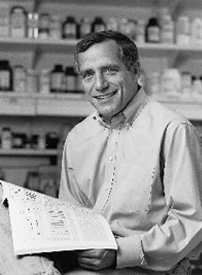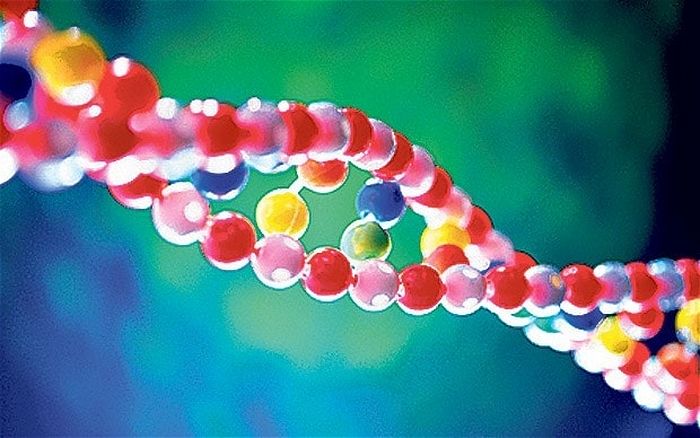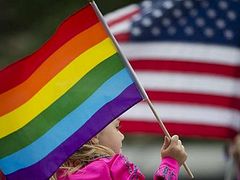In light of the confusion stirred in some readers of recent texts on Social Media and other online portals, regarding the Church’s clear teaching on homosexuality and the pastoral need to care for those suffering in particular from the social trend to regard it as “natural” or a thing to be accepted as part of human nature, the following text is provided for contrast. Presented as a “reference text” at a clergy meeting of the Russian Orthodox Church Outside of Russia in the USA last year, it offers a clear response to many of the social arguments used in the attempt to diminish the Church’s pastoral teachings, which always aim for the loving care and conversion of all who fall into any sin.
OrthoChristian.com is offering this in-depth report as a series of posts.
The entire PDF version of this article can be found here.
See Part 2: The Process of Change in the United States
Our discussion of the science of homosexuality will systematically refute numbers 1, 2, and 3 of the “four core beliefs.” Number 4 will be examined in the context of Christian anthropology—i.e., the Church’s understanding of the human person and condition in the world.
First, what is the incidence of homosexual identity in the general population?
The National Health Interview Survey (NHIS), which is the government’s principal tool for assessing Americans’ health and behaviors found that 1.6 percent of adults self-identify as homosexual, while 0.7 percent consider themselves bisexual.
This is consistent with the 2013 Centers for Disease Control and Prevention (CDC) survey, in which 2.3 percent of the population identifies itself as homosexual or bisexual. This was the first large-scale government survey measuring Americans’ sexual orientation.
Separately, an analysis of 2014 CDC survey data in 19 states, by the Williams Institute at the UCLA School of Law found that 0.6 percent of adults self-identify as transgender.
The overwhelming majority of adults, 96.6 percent, labeled themselves as heterosexual in the 2013 survey. An additional 1.1 percent declined to answer, responding “I don’t know the answer,” or that they were “something else;” this percentage (and the latter response) is consistent with the number of people who self-identify as “asexual”, a choice not provided in the NHIS.
The figures are lower than some earlier estimates of the size of the homosexual and bisexual population, which have typically placed the overall proportion of homosexual identity among men at 2.8 percent and among women at 1.4 percent (an aggregate rate of 2.1 percent), and bisexual identity at 1.8 percent. Needless to say, these figures are all dramatically lower than the long-discredited Kinsey “10 percent.”
Recent surveys in the UK and Western Europe yield similar results.
Belief 1
Let’s consider each of the “four core beliefs”. The first was: Homosexuals are born that way.
Is homosexuality genetic? Is it innate? Or in colloquial language, are homosexuals “born that way”?
In reality, the proper scientific question should be, in the words of one psychiatrist,
To what degree is homosexuality (or any other behavioral trait) genetic and non-genetic, innate and acquired, familial and non-familial, intrauterine-influenced and extrauterine-influenced, affected by the environment and independent of the environment, responsive to social cues and unresponsive to these cues, and when and in what sequence do these various influences emerge to generate their effects and how do they interact with one another; and after we have put these all together, how much is left over to attribute to choice, repetition, and habit?1
This is a much more difficult question to answer, although it is the proper scientific question. However, let us consider our original questions.
To begin, we should first clarify the distinction between “genetic” and “innate.” A trait is “genetic” if it is found in the subject’s genetic coding, and consequently heritable from generation to generation. Such genes may be expressed, not expressed (e.g., recessive), or partially expressed (usually through the action of multiple genes).
“Innate” is a much broader term that encompasses both traits that are genetic, and those which are acquired through other physical/biological means, such as the action of hormones and other influences on intrauterine development.
With respect to a purely genetic link to homosexuality, some scientific research exists.
 Dean Hamer. Source: Center for Cancer Research
Dean Hamer. Source: Center for Cancer Research A larger study of gay brothers in 2013 at Northwestern University, using the many genetic markers now available through the Human Genome Project, tended to confirm Hamer’s work. A region of the X chromosome called Xq28 had some correlation with men's sexual behavior—although scientists had no idea which of the many genes in the region are involved, nor how many lie elsewhere in the genome. Another stretch of DNA on chromosome 8 also appeared to play a role in male sexual orientation—though again the precise mechanism was unclear.
Much recent work in psychiatric genetics indicates that expression of traits is often correlated not simply with the presence or absence of a genetic marker, but by the number of copies of a particular gene in the DNA (i.e., by the number of copy number variants, or CNVs)—which considerably complicates any predictive analysis.
What is striking about these gene studies, in general, is how weakly they correlate with actual expressed sexual identity. Studies of identical twins, which share exactly the same DNA, show that the identical twin of a homosexual man is more likely to identify as straight than gay.2 This means that even a perfect genetic test, which recognized every gene linked to sexual orientation, would less predictive of future orientation than flipping a coin.
For this reason, it is best to regard genetic markers as predisposing, but by no means determinative. Similar genetic markers exist for both alcoholism intrauterine drug addiction. To use an athletic example, genes for height may predispose one to play basketball, but do not mean that one will necessarily participate in the sport.
Compared to the search for “gay genes”, the research into intrauterine influences reveals more candidates. Hormones have an important role in fetal sex differentiation, and so anomalies in hormonal exposure may affect sexual orientation or gender identity in the developing fetus.
Recent studies have provided evidence suggesting the effect of prenatal androgen levels on future sexual behavior. It has long been known, for example, that birth order is correlated with incidence of homosexual identity (younger brothers have a higher rate), and androgen levels are known to vary with birth order. Similarly, stress hormones can cross the placental barrier and interfere with a fetus’ production of sex hormones, and studies have suggested that maternal stress during pregnancy is correlated with a higher incidence of homosexual and bisexual identity in offspring.
There are a number of other hormones potentially implicated in a predisposition to homosexuality, but the research is typically only suggestive, rather than conclusive.
Again we refer back to the identical twin studies. Identical twins are not only genetically the same, they also have the same intrauterine influences. As we noted before, the identical twin of a homosexual man is more likely to be straight than gay. That means that even a full accounting of all genetic and intrauterine effects—that is, all innate factors—is still less predictive of future sexuality than flipping a coin.3
Biological determinism is a double-edged sword for gay activists, as they sometimes only belatedly realize. Modern medicine allows for prenatal genetic screening, which can be used to abort fetuses with a predisposition to homosexuality. Similarly, intrauterine influences predisposing to homosexuality may be treatable in future during pregnancy, just as we administer folic acid to mothers to prevent spinal bifida.
However, any science that overtly seeks to correct errors in sexual orientation is subject to attack by gay activists and their allies.
In 1995, Oregon Health Sciences University (OHSU), Oregon State University (OSU), and the USDA Sheep Experiment Station at Dubois, Idaho, began researching the phenomenon of “male-oriented” rams—obviously less valuable for breeding purposes—with a view to identifying genetic markers or developing prenatal corrective treatments. In 2006, this project came to attention of gay activists, and prominent homosexuals such as Martina Navratilova loudly decried the study.4 To their credit, OHSU and OSU have continued the research, which suggests that intrauterine hormonal effects may keep the brain from fully masculinizing, leading to sexually male-oriented rams.5
If genetic and intrauterine influences are less predicative of future sexuality than a coin flip, then clearly, post-natal environmental factors must be of great importance: family structure, socialization, personal choices and experiences. There is no question that these environmental influences have a significant influence on the development of sexuality; in fact, there were over eighty years of research and clinical experience in this field that the APA chose to overlook in its 1973 decision.
The clinical and research record indicates that in the background of homosexuals one or more of the following is often present:
-
an emotional mismatch between the child and same-sex parent, such as the overt or implied rejection by a hyper-masculine father of a son who is sensitive by nature and unenthusiastic about the father’s interests
-
an emotional mismatch between the child and the opposite sex parent, creating alienation towards the opposite sex
-
sexual abuse of the child by either parent
-
a rejection of the child by his or her same-sex peers
The first of these may give rise to a profound longing for love from that parent, a longing that may be enacted in later relations with peers of the same sex. This longing may also become sexualized—that is, linked to the anxiety-relieving capacity of orgasm.
The second of these may give rise to the child’s fear of that parent, which will likely show itself later as a heightened wariness and avoidance of opposite-sex relations.
It should be mentioned that support for these concepts is hardly limited to those who see homosexuality in negative terms. Social critic and historian Camille Paglia, herself a prominent homosexual figure for decades, strongly supports this view. Dr. Paglia wrote the following:
I have said many times before that I do not believe homosexuality is inborn but that it is an adaptation to specific circumstances and possibilities. What many gay men are remembering as their innate gayness was in fact some other attribute (often an artistic gene) that may have led to a dislocation from roughhousing male bonding. The sex instinct, which comes later, is in my view heavily symbolic among human beings . . . . I understand the biological imperative of hormones, which drive male and female to mate and reproduce. But why is anyone entirely gay? It seems incontrovertible to me that at root there is indeed a dissatisfaction of some kind with the opposite sex, grounded in early experiences and reinforced in adolescence. There is not a single gay person whom I have known over the course of my life since high school for whom childhood factors played no role whatever in his or her adult choice. And yes, behavior is a choice, even if fantasy and imagination are uncontrollable.6
Many studies describe the complex interactions between these and other factors, which are characterized as “psychic traumas.” What is important to recognize is that first, the susceptibility to such traumas varies widely between individuals (i.e., some are highly sensitive to these influences, while others are more resilient), and second, that it is the individual’s perception of these influences that is decisive, rather than an objective measure of harmfulness. Obviously, sexual or physical abuse are objectively harmful, although individual resilience varies; emotional factors are more subjective and difficult to quantify. This point should be emphasized because parental behavior, for example, can range from being objectively “bad” to “good,” while still not meeting the needs of a child, through no fault of the parents.
Although these types of trauma are unusually common in the childhoods of homosexuals, there may be other, less typical, traumas present. Even more generalized disturbances in family life, such as parental separation and loss, are correlated with an increased incidence in homosexual identification.
Whatever the source of trauma, it can lead to the use of self-medicating, anxiety-reducing behaviors: alcohol and drug abuse, promiscuity, homosexuality, and others. An individual will often combine more than one of these behaviors; hence, the correlation between homosexuality, and drug and alcohol abuse. These behaviors are at first soothing, then habitual, then compulsive, and finally addictive.
As with many behaviors, repetitive experiences of these kind rewire the brain (specifically, the neocortex) over time; we become “hard wired” to certain behaviors. This physically alters the brain in ways that cannot be entirely undone, if at all, and so will be modified only with great difficulty. Connections in the pleasure centers of the brain are particularly powerful, releasing opioid chemicals; the pleasure areas of the brain are most intensely activated at the moment of sexual orgasm; this is why any time chastity is lost, the road back to it is so difficult. Modification therefore requires a greater effort of will, additional repetition of the new behavior, and more time, the more deeply embedded in the brain the old behavior has become.
Belief 2
Let’s consider the second of the “four core beliefs”: Same-sex attraction is immutable.
Is same-sex attraction, from whatever combination of innate and environmental factors, immutable? Can it be altered through treatment?
The answer to the first question is unquestionably, “no”; to the second, a qualified “yes”.
With respect to the first, we may begin with a basic statistic: three out of four boys who think they are homosexual at age 16 aren’t by age 25, with no intervention whatsoever.7 That sexual identity is mutable is an evident fact, not even worth serious debate.
In discussing the treatment of same-sex attraction or active homosexuality, the chilling effect of the suppression of science should again be noted. Between 1966 and 1974, over one thousand articles on the treatment of homosexuality were published in academic and professional journals; between 1975 and 1979, forty-two; in the early 1990s, one.
Notwithstanding the suppression of research and the discouragement of clinical practice, many groups across the country do treat homosexuality, with a success rate at least comparable to the treatment of other addictions. Since most of these (although not all) are ministries that generate little “hard” data, this enables hostile skeptics to remain invincibly resistant to acknowledging their effectiveness.
As has been suggested, the success rate varies significantly based on the extent to which habituation has taken place. For those who have not yet begun acting on the behaviors that lead to addiction, education and counseling can be very effective. Once addiction is present, the therapeutic needs become dramatically different.
In 2003 testimony, psychiatrist Jeffrey Satinover noted
A review of the research over many years demonstrates a consistent 30-52 percent success rate in the treatment of unwanted homosexual attraction. Masters and Johnson reported a 65 percent success rate after a five-year follow up. Other professionals report success rates ranging from 30 percent to 70 percent.8
Remarkably, Dr. Robert Spitzer, who as head of the APA nomenclature committee had written and steered through the 1973 DSM change, came to agree. In 2001 he conducted his own study of 200 subjects on the mutability of sexual identity, expecting it to discredit therapeutic approaches. Instead, he found the contrary. Spitzer wrote:
There is evidence that change in sexual orientation following some form of reparative therapy does occur in some gay men and lesbians . . . the majority of participants gave reports of change from a predominantly or exclusively homosexual orientation before therapy to a predominantly or exclusively heterosexual orientation in the past year . . . I approached this quite skeptical, and I’ve been convinced otherwise.
Warned that publication of his paper would constitute professional suicide, Spitzer nevertheless delivered it at the 2001 annual APA meeting9 and submitted it to the journal Archives of Sexual Behavior.10 Retribution was not long in coming, as gay activists furiously attacked this “treason” from a figure prominent in their founding mythology. Spitzer for years defended his work, nor were any flaws in it ever found. However, social pressure took its toll, and in 2012, nearly 80 years old and suffering from Parkinson’s, Dr. Spitzer “recanted” before gay activists. His Dutch colleague, Dr. Gerard van den Aardweg, said that in discussing potential follow up research with Dr. Spitzer, the latter replied that “he would never touch the whole subject ever again. He had nearly broken down emotionally after terrible personal attacks from militant gays and their supporters. There was an outpouring of hatred.”11
In an affidavit, Dr. Michelle Cretella testified that
Despite Dr. Spitzer’s “apology” to the homosexual community for publishing this study, there has been no new data to contradict his original results. Dr. Spitzer’s research remain scientifically sound, and his original conclusion—that some highly motivated individuals with unwanted homosexual attraction can change—still stands. This is why Dr. Kenneth Zucker, editor of the Archives of Sexual Behavior, never published an official retraction of Spitzer’s study.12
Dr. van den Aarweg reported similar results from his own therapeutic work:
From extensive analysis of a series of 101 persons I had in treatment, I have derived the following summarizing statements about the effectiveness of our therapy. Of those who continued treatment—60 percent of the total group—about two-thirds reached at least a satisfactory state of affairs for a long period of time. By this is meant that the homosexual feelings had been reduced to occasional impulses at most while the sexual orientation had turned predominantly heterosexual, or that the homosexual feelings were completely absent, with or without predominance of heterosexual interests.
Of this group, however, about one-third could be regarded as having been changed “radically”. By this is meant that they did not have any more homosexual feelings, and in addition that they showed a fundamental change in overall emotionality from negative to positive—from instability to reasonable, normal stability—with a follow up period of at least two years.13
If same-sex attraction is sometimes mutable, it cannot be immutable.
One thing should be emphasized: all of the foregoing information relates to unwanted same-sex attraction. Once an individual has embraced a homosexual identity, these statistics no longer apply. Sometimes clergymen are approached by parents whose child has “come out” to them as homosexual and asked, “Is there some place we can send them?” The answer to this is no, unless the child is ambivalent or unhappy about their same-sex sexual attractions.
Belief 3
Let’s consider the third of the four core beliefs: Homosexuality is normal. Is homosexuality “normal”? Are active homosexuals “just like everyone else” from a social standpoint, with the exception of whom they love?
The answer of science to that question, from a medical and epidemiological standpoint, is that active male homosexuality is a serious public health issue. Female homosexuality, despite differences in sexual practices and a far lower level of promiscuity, also has a surprisingly high correlation with early mortality.
A principal driver in male homosexual health outcomes is the practice of anal intercourse, which is practiced by a large majority of homosexual men. The most rigorous single study, the Multicenter AIDS Cohort Study of nearly five thousand homosexual men, found that over 80 percent had engaged in receptive anal intercourse in the previous two years. It should be noted that these adverse health outcomes would exist even in the absence of the human immunodeficiency virus, or HIV. The lining of the rectum is quite fragile—very unlike the construction of the vagina. Anal intercourse tears the rectal lining of the receptive partner, regardless of whether a condom is worn, and the subsequent contact with highly toxic fecal matter leads to a host of diseases, many of which are virtually unknown among non-homosexuals.
The risk of anal cancer soars for those engaging in anal intercourse. According to one study, it rises by an astounding 4,000 percent, and doubles again for those who are HIV positive.14
When combined with promiscuity and other oral-anal practices of active male homosexuals, the litany of their characteristic illnesses is extensive, and should be sufficient to establish the public health dimensions of these behaviors. These include:
-
the usual sexually transmitted diseases, such as gonorrhea, Chlamydia trachomatis, syphilis, herpes simplex virus, human papilloma virus, pubic lice, and scabies
-
enteric diseases, such as infections with Shigella species, Campylobacter jejuni, Entamoeba histolytica, Giardia lamblia (“gay bowel disease”), Hepatitis A, B, C, and D, and cytomegalovirus
-
trauma, related to and/or resulting in fecal incontinence, hemorrhoids, anal fissures, foreign bodies lodged in the rectum, rectosigmoid tears from the insertion of foreign objects, allergic proctitis, penile edema, chemical sinusitis, inhaled nitrite burns, and sexual assault of the patient
-
throat and oral cancers
-
and last, but certainly not least, acquired immunodeficiency syndrome, or AIDS
Again, it must be emphasized that many of these problems are independent of whether or not condoms are worn. And many homosexual men, particularly those in long-term relationships, prefer not to use them. In their absence, various immune diseases can be added to the list, stemming from the introduction of foreign biological matter into the intestinal tract. And some are related to sexual practices other than anal intercourse.
Promiscuity is a striking characteristic of male homosexuality. Depending on the survey, monogamy or semi-monogamy (10 or fewer lifetime partners) is practiced by less than 2 percent of respondents.15 Even for those in committed long-term relationships, monogamy is rare. In one study of couples, less than 5 percent maintained fidelity, and of 100 couples in the research that had been together for at least five years, none had.16 The Multicenter AIDS Cohort Study found that a significant majority of men (69-83 percent) reported having 50 or more lifetime sexual partners.
Other studies report dramatically higher numbers; one study found that 43 percent of male homosexuals estimated having sex with 500 or more different partners, and 28 percent with 1,000 or more different partners. Seventy-nine percent said that more than half of these partners were strangers, and 70 percent said that more than half were men with whom they had sex only once.17
These numbers rise with age, as one would expect; many older respondents return answers such as “over 1,000”, “too many to count”, or “I have no idea.” Average partners during the last twelve months average eight. If we factor in the reality that male homosexuals are a very small proportion of the population and constitute a relatively closed group, the communicability of illnesses is correspondingly magnified.
By contrast, the authors of Sex in America found that 90 percent of heterosexual women and more than 75 percent of heterosexual men have never engaged in extramarital sex.
These statistics should be sufficient to establish that the behavior of male homosexual couples is not, in general, “just like everybody else.”
A study of data collected by the 2013 and 2014 National Health Interview Surveys by the Vanderbilt School of Medicine and the University of Minnesota School of Public Health18 found significant health disparities among male homosexuals, lesbians, and bisexuals. Compared to heterosexual women, lesbians were 91 percent more likely to report poor or fair health; bisexual women were over 100 percent more likely to report multiple chronic conditions, compared to heterosexual women. Homosexual men, lesbians, and bisexuals were all more likely than their heterosexual counterparts to experience psychological distress, and to drink and smoke heavily.
These characteristic and chronic health problems translate, collectively, to a significant reduction in lifespan for homosexuals, as compared with heterosexuals. In a 1997 study in the International Journal of Epidemiology, the median age of homosexual men dying from all kinds of causes was 42, compared to 75 for married men generally, and 57 for unmarried men generally. And the median age of lesbians at death was 45 compared to 79 for married women, and 71 for unmarried women generally.
It should be noted that this study was done at a time when mortality from HIV/AIDS was much higher than it is today. Since treatment has improved significantly since then, the mortality rate for homosexual men has likely improved. Unfortunately, there is little, if any, recent research specific to this topic, as any research with the potential to cast homosexual behavior in a negative light has become politically toxic to undertake. However, the Vanderbilt/Minnesota study cited above suggests continued poorer health outcomes, and consequent higher rates of mortality.
What is striking in this study is the high mortality for homosexual women, who have been relatively unaffected by the AIDS epidemic, and who generally experience fewer physical illnesses related to promiscuity. This suggests that underlying drivers for them are higher-than-average rates of emotional problems and related addictive behaviors, which, as noted previously, are highly correlated with homosexual behavior.
Statistically, active homosexuality has a negative effect on life expectancy. The “gay lifestyle” is neither gay nor a lifestyle—it is more accurately characterized as a destructive addiction. And like alcoholism and drug addiction, these impacts cannot effectively be addressed except through treatment, behavioral change, and support.
Belief 4
Let’s consider the last of the four core beliefs: Orientation equals behavior and self-identity. Are all the desires that humans experience natural to man, and therefore proper to pursue to the extent they do not involuntarily injure others? And if one is inclined to a certain behavior, does that inclination define one’s essential self?
This is the view of much of contemporary society. If for the Romans homosexuality was a behavior one chose to engage in, today many regard it as a core “identity.” Given this definition, discussion of changing homosexuality is viewed as hating “who someone is,” rather than addressing a behavioral issue.
As Christians, we understand that we were created with a higher part of the soul in spiritual union with God; that we are fallen creatures that have lost that spiritual union, and who therefore are at war within ourselves; and that we earnestly desire, in the very depths of our soul, to reestablish that lost union with God. We may attempt to medicate the pain of that lost union—to fill the resulting void—with many things: money, power, possessions, physical pleasures of various kinds. But none of these things can compensate for that loss; none can cure the underlying illness.
In our fallen state, we have an “orientation” to passions of many kinds. Sexual passions are merely one of these. As fallen human beings, we have an “orientation” to gluttony, an “orientation” to abuse alcohol or drugs, an “orientation” prone to anger and judging, an “orientation” for laziness, an “orientation” of indifference to God and our fellow man. When we treat same-sex attraction as an identity, we are equating an individual with a passion. It is only when we begin to heal our fallen nature that we begin to transcend these “orientations”—our passions—and to live as children of God.
It was to heal fallen mankind that the second Person of the Trinity took on our nature and entered into the world as Jesus Christ, uniting Divinity to our humanity. By this salvific act a path was opened for fallen humanity to enter into union with the Creator, and to become fully realized individuals in God. Having chosen to walk this path and enter the Church is the core “identity” of any Christian. Although one may exercise various roles in society—parent, worker, teacher, student, and the like—none of these roles are “identities” in the same sense that we have an identity as Christians.
As we are created as a natural union of soul and body, our gender identity is mirrored within soul and body. In our fallen state, the intrinsic harmony of soul and body is lost; the body no longer serves the soul, but struggles with it. If our psychological identity and urges are at variance from our body’s gender, this is also a consequence of the Fall and the resulting struggle. This is in stark contrast to the attitudes of our secular society, which assigns, as did the ancient Greeks, personal identity entirely to the mind. This essentially pagan, secular attitude was eloquently expressed by Chastity Bono (daughter of singers Cher and Sonny Bono) on Good Morning America, shortly before beginning sexual reassignment surgery: “Gender is between your ears, not between your legs.”
And so to the question recently posed to one Christian leader in a public hearing, and to which he gave a halting and most unsatisfactory answer—“Do you believe that God made me gay?”—we can confidently give an answer to the correct, if only implied, question, “No, God did not create anyone to live their life as a homosexual.”
Next: An All-Embracing Mythology








But it would be very helpful to know who the author is!!